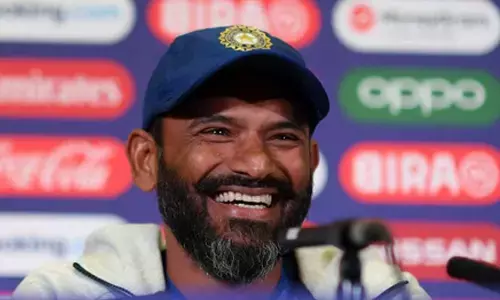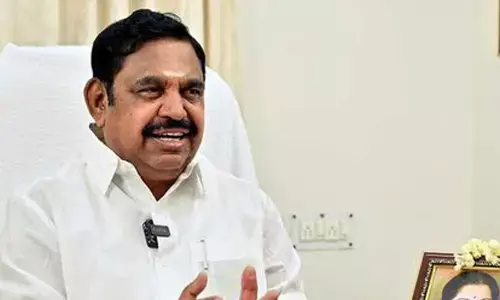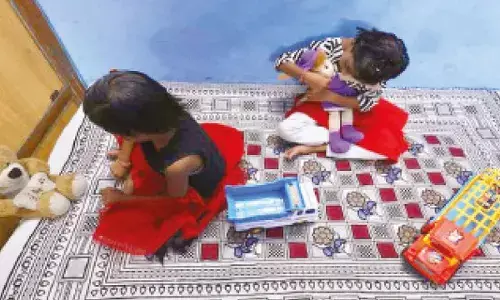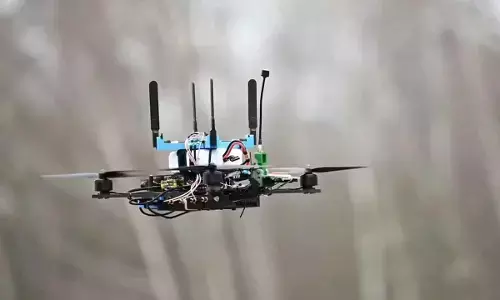Discreditable dithering

“We are going to continue our meeting on August 26, 27 and 28,” Digvijay Singh, AICC general secretary in charge of AP, told media on Tuesday in Delhi after the Antony Committee had “patiently” heard Seemandhra Congress leaders. Digvijay also complimented Chief Minister Kiran Kumar Reddy for handling a very difficult situation. Antony and his colleagues seem to have unlimited patience. Do the people of Andhra Pradesh have any more patience, which the Congress party and the UPA dispensation have been testing for almost a decade?
Little do the politicians realize that the people of AP are sitting on an active volcano which might erupt any moment. One violent incident in Hyderabad caused by unsocial elements, if not by ruthless political thugs, is enough to create a civil-war like situation
“We are going to continue our meeting on August 26, 27 and 28,” Digvijay Singh, AICC general secretary in charge of AP, told media on Tuesday in Delhi after the Antony Committee had “patiently” heard Seemandhra Congress leaders. Digvijay also complimented Chief Minister Kiran Kumar Reddy for handling a very difficult situation. Antony and his colleagues seem to have unlimited patience. Do the people of Andhra Pradesh have any more patience, which the Congress party and the UPA dispensation have been testing for almost a decade?
The Antony Committee has met almost all the Congress stakeholders, if the politicians who have proved beyond doubt to be rabid opportunists can be described as such. The Committee had met Congress leaders from all regions and members of the AP Cabinet and Union Ministers from the State. Whom else does the Committee, which is essentially a party arrangement to hear the views of its leaders, wish to meet? How long do the Congress leaders plan to prolong this debilitating drama?
Digvijay, a two-term Chief Minister and a senior leader, does not seem to be in a hurry. The agitation of the Seemandhra people for the last three weeks has no bearing on the Congress leadership. Or is it the case of the Congress leaders in Delhi trying to hunt with the hound and run with the hare? To what length should this ugly and uncivilized spectacle go on?
Little do the politicians realize that the people of AP are sitting on an active volcano which might erupt any moment. One violent incident in Hyderabad caused by unsocial elements, if not by ruthless political thugs, is enough to create a civil-war like situation.
The UPA-II is in a chaotic mess of its own making. The rupee is falling every day. The price of onions, which has a history of defeating the ruling parties, is soaring. Parliament’s monsoon session will be over tomorrow without transacting any worthwhile business.
There have been a series of incidents along the border (LOC) with Pakistan. The Chinese soldiers have crossed the Actual Line of Control (ALOC) and intruded into Arunachal Pradesh for more than 20 miles. If the war clouds are looming as the general elections are approaching, people tend to take it as a tactic by the UPA-II. There have been occasions in history of nations when a weak government embarked upon war with a neighboring country to arouse spirit of nationalism only to be cashed in by the ruling party or coalition during the elections.
The euphoria created by the Kargil War helped the NDA at the national level and the TDP in AP in 1999 elections. But is the UPA-II, which has taken a lot of beating what with a series of scams, policy paralysis, economic mismanagement and general decline in its credibility, capable of creating a crisis and resolving it so as to reap electoral dividends? With the present downcast mood and deflated morale, it is most unlikely that the Sonia-Manmohan duo would venture to go to war.
It seems to be the question of unending tactics of using sentiments and emotions of the people for electoral gains, at which the Congress is a past master. The Prime Minister or the UPA chairperson has done precious little to address the concerns so loudly and clearly expressed by the people of Seemandhra. The first and foremost concern is about Hyderabad.
River water sharing, power sharing in terms of generation and distribution, and employment and education opportunities are other major points of worry for the people on the coastal side of the divide. There is no change in the rhetoric by the Congress leaders from Seemandhra region. They met the Antony Committee at the War Room and told the media that there is no change in their stance. Nothing short of united AP is acceptable to them.
Digvijay comes out a little later and says very little and goes away. It is quite apparent that they are playing to the gallery. If Congress leaders assume that they are going to be benefited by allowing the flames in Seemandhra to rise unabated, they are committing yet another blunder. After the CWC and the Coordination Committee of the UPA took a unanimous decision to concede the Telangana demand, the Congress has already lost considerable ground. The YSRCP has been leading the movement which looked spontaneous to start with. Leaders of all parties did not prepare themselves and the people for a decision by the Congress.
The Congress party, however, has given enough time for the Opposition parties to get over the initial shock and get their act together. The YSRCP had decided to forgo Telangana and focus on Seemandhra. TDP leaders in Seemandhra are a little behind the YSRCP but they are catching up steadily. The Congress leaders are not able to physically go to their constituencies and, therefore, are exerting pressure on their party leadership to backpedal the decision. They cannot go to the people unless some statement suggesting rethinking or reviewing on the part of the party high command is issued by the AICC.
In the meanwhile, protagonists of Telangana statehood are subscribing to the view that Sonia is unable or unwilling to rush things and the implementation of the decision might be delayed beyond general elections. The three weeks since the CWC decision have helped K Chandrasekhara Rao(KCR), president of the Telangana Rashtra Samithi (TRS) to overcome depression on account of not being consulted by the Congress leadership before the momentous decision was taken. He is now planning a bus yaatra in Telangana districts. He would be trying to build his party now by appointing district and mandal-level bodies. Hyderabad is a very evocative issue in Telangana and KCR has the potential to exploit it to the full.
TDP chief Chandrababu Naidu is also preparing for a bus yaatra from Vizag very soon. A dynamic and energetic leader that he is, he cannot obviously sit at home for long. When the YSRCP honorary president began a fast demanding that the Congress party should take back its decision and keep the State united, the TDP could not take a similar stand for fear of getting branded as opportunistic. Naidu who has had a series of meetings with senior journalists this week has expressed his concern over Hyderabad.
He is understood to have commented that Telangana alone cannot have full claim over the city which he developed as an international IT destination. It is entirely up to him to decide whether to tread a new path and behave like a maternal uncle when brothers decide to part ways or try to keep the State united by taking advantage of the pusillanimity that is preventing the Congress high command from taking fast decisions.
We can only remind Sonia Gandhi of a page in recent history. What happened at the time of formation of Gujarat and the movement for Punjabi Suba would be instructive for her. The Maharashtra Assembly passed a resolution saying that, besides creating Maharashtra and Gujarat States, Bombay had to be made a Union Territory (UT). But the Parliament, when it considered the Maharashtra Assembly resolution, amended the resolution and finally resolved that Bombay would be part of Maharashtra.
Indira Gandhi took over as Prime Minister on January 24, 1966, in the wake of Lal Bahadur Shastri’s demise at Tashkent. By that time Shastri had approved the proposal to divide Punjab State into three parts-Punjabi-speaking areas as Punjab, Hindi-speaking as Haryana and Pahari-speaking hilly areas to go to Himachal Pradesh.
The decision of the government was a token of appreciation for the patriotism and valour displayed by the Punjab jawans and officers of the Indian Army and the people of Punjab in defending the western front. Let us see the speed with which decisions were taken at that time. While the ceasefire was declared on September 22, 1965, Gulzari Lal Nanda, then Home Minister, announced in Parliament the next day, September 23, the constitution of a Cabinet Committee to take a decision on the division of Punjab. Indira Gandhi, YB Chavan and Mahavir Tyagi were the members.
Lok Sabha Speaker Hukum Singh appointed a Parliamentary Committee with 22 members who included stalwarts like Hiren Mukherjee (CPI), Atal Behari Vajpayee (Jan Sangh) and Surendranath Dwivedi (Socialist Party). The Committee received 2,200 memoranda in favour of Punjabi Suba and 903 against it. However, Hukum Singh could convince all members and managed to get a unanimous report in favour of creating Punjab State comprising Punjabi-speaking areas.
The Parliamentary Committee report was handed over on March 15, 1966. The Congress Working Committee resolved even earlier, on March 9, 1966, to go for division. The report of the Parliamentary Committee was made public within three days of its submission, on March 18. The then Prime Minister Indira Gandhi conceded the demand on April 23, 1966, in less than three months of taking the reins as Prime Minister. Then a Commission was appointed to demarcate borders of Punjab and Haryana.
On September 3, the Punjab Reorganisation Bill was introduced in the Lok Sabha, and on November 1st, the Punjabi-speaking State became a reality. On March 9, 1967, Giani Gurnam Singh Musafir became its first chief minister. What happened before the decision was implemented by Indira Gandhi was important. Ram Kishan was the Chief Minister of Punjab at that time. He did not agree with the decision to bifurcate Punjab and refused to cooperate. Indira Gandhi dismissed him on July 5, 1966, and imposed President’s rule and kept the Assembly in suspended animation. Since Article 356 was in operation (according to which President’s rule was imposed), Article 3 remained suspended and the Parliament directly passed the resolution. When the matter was taken to the Supreme Court, it upheld the decision of the government. All this was in a matter of only six months after she became Prime Minister.
Indira Gandhi at that time was not so clever as Sonia and her advisors today to think of making use of the emotions of the people to garner votes. Indira Gandhi, with all her faults and the Emergency excesses, loved the people of this country. She had her tactics but not at the cost of the welfare of the people. Sonia, on the other hand, allowed her deputies to play with the lives of the Telugu-speaking people for years. She has to stop this game at least now.
Instead of being steadfast in implementing the decision, Sonia Gandhi is allowing her advisors to play with fire by allowing tempers in Seemandhra to rise. Whatever political assurances and constitutional guarantees that have to be given to the people of Seemandhra should be decided and incorporated in the Bill to be introduced in Parliament in its winter session if Sonia wants to adhere to her decision. Otherwise, she can tell the nation that she is not able to implement the CWC decision. But doing nothing when AP is burning and the lives of the people are ruined and hatred between brothers and sisters is brewing is something that history would not excuse.
People who have been wary of Narendra Modi, who was described as maut ka saudagar (merchant of death) by Sonia Gandhi in 2007 elections, are slowing becoming his admirers thanks to the indecisiveness of the UPA-II and its utter failure on the economic front. Modi, though he looks like a dictator brooking no advice, is at least decisive. He would take a decision, good or bad. A bad decision is better than no decision.




















